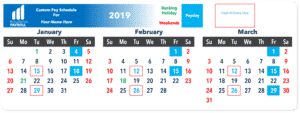
Junk bonds have higher yields and lower prices than other corporate bonds because there is elevated risk. This is usually because the company is losing money or is in a bad financial position. Bonds are issued by a business or a federal, state, or local government to raise capital. “Par value” is the face value of each bond—it is what the bond costs and the amount that the business or institution promises to pay back at the end of the bond term. A bond premium occurs when the price of the bond has increased in the secondary market due to a drop in market interest rates.

It makes the bond more attractive, and it is why the bond is priced at a premium. If market interest rates decrease, then bond prices increase. It is because stated coupon rates are fixed and do not fluctuate. These boxes may be used by payers who participate in the Combined Federal/State Filing Program and/or who are required to file paper copies of this form with a state tax department.
Our Company
Although you will owe federal taxes on income from government bonds such as Treasury bills and notes, your earnings are tax-free at the state and local levels. However, it is not necessary for investors to amortize premiums in the year they buy the bond, because they may begin doing so in any tax year. But it’s important to remember that investors who elect to amortize the premium for one bond must also amortize the premium for all other similar bonds, both for that year and for years going forward. Furthermore, investors who amortize the premium from a bond must reduce the cost basis of their positions by equivalent amounts. It is also possible that a bond investor will have no choice. For example, if the investor wants to purchase a bond with a high rating that matures in 8 years, perhaps only one bond will be available.
- Bonds trade on a secondary market, so the price of the bond floats either below or above the original par value based on supply and demand.
- This includes bonds from the Federal Home Loan Bank, Financing Corporation, and Tennessee Valley Authority, among others.
- He graduated from Goldsmiths, University of London, with a BA in journalism before moving to a financial content agency.
- Every year, bondholders receive IRS tax form 1099-INT and use it to report their annual taxable interest income.
SmartAsset Advisors, LLC (“SmartAsset”), a wholly owned subsidiary of Financial Insight Technology, is registered with the U.S. SmartAsset does not review the ongoing performance of any RIA/IAR, participate in the management of any user’s account by an RIA/IAR or provide advice regarding specific investments. An author, teacher & investing expert with nearly two decades experience as an investment portfolio manager and chief financial officer for a real estate holding company. The gap between a bond’s original par value and its premium value can shift as the bond gets closer to its maturity date. Generally, the closer a bond is to maturity the lower the premium tends to be. It can eventually diminish to zero as the bond’s price once again becomes equivalent to its par value.
Access additional help, including our tax experts
This is when it returns to its investor the full face value of when it was issued. Absent any unusual events, the shorter the time until a bond matures, the lower the potential premium or discount. There will be a higher amount of bonds selling at a premium in the market during those times when interest rates are falling. This happens because investors are getting more income from them.
A well-diversified portfolio may be able to support the additional risk in exchange for a higher yield. Calculating the bond premium or discount for trading bonds is more complex. It requires issuers to measure the present value of the payments from the bond using the market interest rate. Assume that a corporation prepares to issue bonds having a maturity value of $10,000,000 and a stated interest rate of 6%. However, when the 6% bonds are actually sold, the market interest rate is 5.9%. Since these bonds will be paying investors more than the interest required by the market ($300,000 semiannually instead of $295,000 semiannually), the investors will pay more than $10,000,000 for the bonds.
Interest rate hikes, jobs forecast, commercial property death spiral … – InvestmentNews
Interest rate hikes, jobs forecast, commercial property death spiral ….
Posted: Mon, 31 Jul 2023 11:39:57 GMT [source]
For example, a bond with a par value of $1,000 that costs $1,050 will be quoted as “105”. A holder’s odds of winning remained at 24,000 to 1 in July, though were more £100,000, £50,000, £25,000, £10,000 and £5,000 prizes available. If you hold Premium Bonds and want to check if you’ve won a prize in the latest monthly draw, you can use the NS&I online prize checker here. To get it set up, you’ll need to activate the NS&I Premium Bonds prize checker skill on your Alexa app and enter your NS&I number.
NS&I August Premium Bonds draw – check for prizes now
However, if you received both IRS notices in the same year, or if you received them in different years but they both related to information returns filed for the same year, do not check the box at this time. For purposes of the two-notices-in-3-years rule, you are considered to have received one notice and you are not required to send a second “B” notice to the taxpayer on receipt of the second notice. See part N in the current General Instructions for Certain Information Returns for more information. A bond’s price in relation to its par value is just one factor for investors to consider.
Keep the information for each state separated by the dash line. If you withheld state income tax on this payment, enter it in box 14. In box 12, enter the abbreviated name of the state, and in box 13, enter the payer’s state identification number. The state number is the payer’s identification number assigned by the individual state. If you withheld state income tax on this payment, you may enter it in box 17. In box 15, enter the abbreviated name of the state, and in box 16, enter the payer’s state identification number.
Now, no one can guarantee that their next picks will be as strong, but their 20 year track record continues to beat every other stock newsletter we follow. They do pick some losers, but the key for investors is to invest equal dollar amounts in all of their picks. So if you have $1,000 to invest in the market each month, buy $500 of each of their 2 monthly stock picks. Using the previous example of a bond with a par value of $1,000, the bond’s price would need to fall to $750 to yield 4%, while at par, it yields 3%. This is a discounted bond, meaning an investor would pay less for the same yield, making it a better option.
Expert does your taxes
To meet the statement requirement, you may furnish a copy of Form 1099-OID and a separate statement containing the additional information to the REMIC or FASIT regular interest or CDO holder. Enter the regular interest holder’s pro rata share of investment expenses. You may enter an “X” in this box if you were notified by the IRS twice within 3 calendar years that the payee provided an incorrect TIN.
Since bondholders are holding higher-interest paying bonds, they require a premium as compensation in the market. The unamortized bond premium is what remains of the bond premium that the issuer has not yet written off as an interest expense. An unamortized bond premium refers to the difference between a bond’s face value and its sale price. If a bond is sold at a discount, for instance, at 90 cents on the dollar, the issuer must still repay the full 100 cents of face value at par. Since this interest amount has not yet been paid to bondholders, it is a liability for the issuer. A premium bond tends to be less sensitive to changes in interest rates than a discount bond because its duration is lower and its coupon rate tends to be higher.
Eight decades of The Sentinel and the Fair Premium Book – Goldendale Sentinel
Eight decades of The Sentinel and the Fair Premium Book.
Posted: Wed, 02 Aug 2023 15:36:00 GMT [source]
The existence of a fiduciary duty does not prevent the rise of potential conflicts of interest. When deciding whether to invest in bonds, it’s also important to look at the bigger picture to determine whether it’s a good fit for your investment strategy. Keeping the interest rate environment in focus can also help you to gauge which way bond prices are likely to move, at least in the near term. Or, if you choose to reduce the tax exempt interest by the premium paid for the bond, it must be amortized. Bond insurers generally insure only securities that have underlying ratings in the investment-grade category, with un-enhanced credit ratings ranging from BBB to AAA.
Just remember to have your Premium Bonds holder’s number to hand. A bond discount is the amount by which the market price of a bond is lower than its par value (typically $1,000) due at maturity. Bond prices are quoted as a percentage of face value, so a price of 95.00 means that the bond is selling for 95% of its face value of $1,000.00 and the bond discount is 5%. Calculating these bond premium and discount are straightforward. A bond is a debt instrument that allows issuers to raise debt finance.
Also, use Form 1099-OID to report other interest accrued to a REMIC or FASIT regular interest holder during the year or paid to a holder of a CDO. You may use Form 1099-INT rather than Form 1099-OID to report interest for an instrument issued with OID if no OID is includible in the regular interest holder’s or CDO holder’s income for the year. Report in box 1 the how to efficiently manage capex capital project management software amount of interest, other than OID, accrued to each REMIC or FASIT regular interest holder or paid to a CDO holder for the period during the year for which the return is made. REMICs, holders of ownership interests in FASITs, issuers of CDOs, and any broker or middleman who holds as a nominee a REMIC or FASIT regular interest or CDO must file Form 1099-INT.
In the U.K., premium bonds are an investment product that enters investors into a monthly prize draw instead of interest payments. If a company is performing well, its bonds will usually attract buying interest from investors. In the process, the bond’s price rises as investors are willing to pay more for the creditworthy bond from the financially viable issuer. Bonds issued by well-run companies with excellent credit ratings usually sell at a premium to their face values. Since many bond investors are risk-averse, the credit rating of a bond is an important metric.

The term “premium bond” has been used in the English language since at least the late 18th century,[6] to mean a bond that earns no interest but is eligible for entry into a lottery. A Premium Bond is a lottery bond issued by the United Kingdom government since 1956. At present it is issued by the government’s National Savings and Investments agency.
Bonds can help to balance out risk in a portfolio while also generating income in the form of interest from regular coupon payments. When a bond is issued it’s assigned a fixed par value and a set maturity date. A bond’s value can change, however, once it begins trading on the open market.

Also, the yield to maturity is stated in annual terms, so semi-annually the yield to maturity is 1.945% (3.89% / 2). A method of amortizing a bond premium is with the constant yield method. The constant yield method amortizes the bond premium by multiplying the purchase price by the yield to maturity at issuance and then subtracting the coupon interest. For example, if a recipient does not furnish its TIN to you in the manner required, you must backup withhold. The applicable interest rate applies to amounts required to be reported in boxes 1, 2, and 8, but is limited to the cash paid on these obligations. Before applying the applicable interest rate, you may reduce the amounts reported in boxes 1 and 2 by the amount reported in box 3.